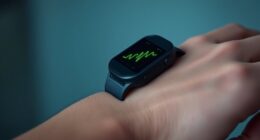Sleep biohacking uses wearables to track your sleep patterns, essential signs, and circadian rhythms, giving you personalized insights for better rest. By adjusting your light exposure, environment, and routines based on this data, you can improve sleep quality and support natural melatonin production. Small tweaks like better room temperature or noise reduction can make a big difference. Keep exploring to discover more ways these tools can help you achieve more restful, restorative sleep.
Key Takeaways
- Wearables monitor sleep stages, heart rate variability, and circadian patterns to identify disruptions and optimize sleep quality.
- Data insights guide personalized adjustments like light exposure, supplements, and environmental changes for better sleep.
- Tracking sleep patterns helps regulate melatonin production by managing light and timing of supplements.
- Creating a sleep-friendly environment with darkness, cool temperature, and noise reduction enhances restorative sleep.
- Experimenting with routines based on wearable data promotes sustainable improvements in sleep duration and quality.

Getting enough quality sleep is essential for your health, but many people struggle to achieve it consistently. One of the most effective ways to improve your sleep is through sleep biohacking, which involves using wearables and data to optimize your rest. A key aspect of this process is melatonin optimization, which helps regulate your sleep-wake cycle. By tracking your sleep patterns with devices like smart rings or fitness trackers, you gain insights into your circadian rhythms. This data lets you make targeted adjustments, such as adjusting your exposure to light or taking melatonin supplements at the right times, to support your body’s natural sleep signals. Ensuring your sleep environment is conducive to rest also plays a crucial role. Creating a dark, quiet, and cool sleep space helps your body produce melatonin naturally, making it easier to fall asleep and stay asleep throughout the night.
Optimize sleep with wearable insights, light exposure, and environment tweaks for natural melatonin regulation.
Using wearables, you can monitor your sleep stages, heart rate variability, and other vital signs, providing a comprehensive picture of your sleep quality. This data allows you to identify patterns or disruptions that might be hindering your rest. For example, if you notice frequent awakenings or shallow sleep, you can experiment with changes to your sleep environment or routines. Many devices also offer insights into your light exposure during the day, which influences melatonin production. By minimizing blue light exposure in the evening and maximizing natural light during the day, you can enhance your body’s ability to produce melatonin naturally, leading to better sleep onset and quality. Additionally, exploring sleep environment factors such as mattress comfort and sleep surface can further improve your rest.
Your sleep environment should be tailored to support these biohacks. Keep your bedroom dark by using blackout curtains, and consider using a sleep mask if necessary. A cooler room — usually between 60-67°F (15-19°C) — can help promote deep, restorative sleep. Reducing noise with earplugs or white noise machines can prevent disruptions, and removing electronic devices minimizes electromagnetic interference. Some wearables also remind you to prepare your environment, such as suggesting when to dim the lights or turn off screens. By combining data-driven insights with environmental tweaks, you markedly boost your chances of achieving ideal sleep.
Incorporating these biohacks into your nightly routine might require some experimentation, but the payoff is worth it. Better sleep enhances mood, cognitive function, and overall health. The key is to use your data to understand what works best for you and to make gradual, sustainable changes. With consistent effort, you’ll find that sleep becomes easier to achieve, more restful, and truly restorative.
Frequently Asked Questions
How Accurate Are Sleep Tracking Wearables Compared to Sleep Studies?
Sleep tracking wearables can be quite useful, but their device accuracy varies compared to sleep studies. While wearables provide convenient, real-time data on your sleep patterns, they often lack the precision of clinical sleep studies. You might see good general trends, but for detailed insights, a sleep study offers more reliable results. Use wearables as a helpful tool, but don’t rely solely on them for serious sleep issues.
Can Sleep Biohacking Methods Work for All Age Groups?
Sleep biohacking methods can work across all age groups by focusing on age-specific strategies and lifespan adaptability. You’ll need to customize your approach to your unique needs, whether you’re a teenager, adult, or senior. By adjusting your routines and using wearables to track progress, you can optimize sleep quality at any age. Consistency and flexibility ensure these techniques support healthy sleep patterns throughout your lifespan.
Are There Any Risks Associated With Using Sleep Wearables Long-Term?
Long-term use of sleep wearables could pose risks like data privacy concerns, where your personal sleep patterns might be shared or hacked, and potential impacts on long-term health if you become overly reliant on device feedback. For example, imagine tracking sleep data for years without understanding how it influences your health decisions. Stay cautious, read privacy policies, and balance wearable insights with medical advice to avoid these risks.
How Quickly Can I Expect to See Improvements in Sleep Quality?
You can typically notice sleep improvements within a week of using wearables for sleep pattern adjustments. As you track your data, you’ll identify trends and make targeted changes, like adjusting bedtime or supplement timing, which enhance sleep quality. Keep in mind, supplement effectiveness varies individually, but consistent use and monitoring can speed up your progress. Stay patient, and you’ll see clearer insights and better sleep in no time.
What Are the Best Wearable Devices for Monitoring Sleep in Athletes?
You should consider the WHOOP Strap 3.0 for monitoring sleep in athletes. It offers high sleep tracking accuracy and features like heart rate variability and recovery insights, vital for optimizing performance. Imagine a pro athlete using WHOOP to fine-tune training based on sleep data, leading to better endurance and quicker recovery. Its extensive metrics give you real-time feedback, helping you adjust habits for improved sleep quality and athletic gains.
Conclusion
By harnessing wearables and data, you’re becoming the captain of your sleep ship, steering through the foggy seas of restless nights toward clearer, calmer waters. Each night’s insights act as your guiding stars, illuminating the path to better zzzs. With every tweak and turn, you’re crafting a personalized lullaby, transforming your sleep into a symphony of restorative harmony. Embrace this biohacking voyage—your journey to dreamland is just a heartbeat away.









